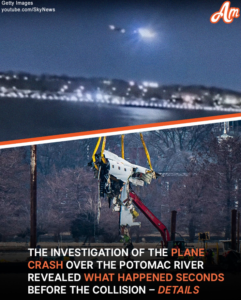On January 29, 2025, a tragic midair collision occurred near Washington, D.C., involving American Airlines Flight 5342, a Bombardier CRJ700, and a U.S. Army Black Hawk helicopter. The accident resulted in the deaths of all 67 individuals on board both aircraft.
Flight Tracking Data and Altitude Discrepancies
Preliminary data from air traffic control radar revealed that the Black Hawk helicopter was operating at an altitude of approximately 300 feet. This exceeded the maximum permitted altitude of 200 feet for its designated flight route. Concurrently, Flight 5342 was descending at around 325 feet as it approached Ronald Reagan Washington National Airport. The minimal vertical separation between the two aircraft left insufficient time for evasive maneuvers, leading to the collision.
Air Traffic Control Communications
Investigations revealed that two minutes prior to the collision, an air traffic controller alerted the Black Hawk crew about the proximity of the CRJ700. Despite this warning, the altitude discrepancy persisted, culminating in the fatal encounter.
Recovery Efforts and Ongoing Investigations
Following the accident, recovery teams, including the U.S. Army Corps of Engineers, initiated operations to retrieve the wreckage from the Potomac River. Significant components of the aircraft, such as the aft fuselage and right engine, have been recovered. As of February 3, 2025, 55 of the 67 victims have been identified. Efforts continue to locate and identify the remaining individuals.
The National Transportation Safety Board (NTSB) is leading the investigation, focusing on several key areas:
- Altitude Compliance: Assessing why the Black Hawk helicopter was operating above its authorized altitude.
- Communication Protocols: Evaluating the effectiveness of air traffic control communications and the response of the flight crews.
- Equipment Functionality: Determining whether the helicopter’s Automatic Dependent Surveillance-Broadcast (ADS-B) system, which provides real-time tracking data, was operational during the flight.
The NTSB plans to release a preliminary report within 30 days of the incident, which will provide more detailed insights into the factors contributing to the collision.
Impact on Aviation Operations
In the aftermath of the crash, the Federal Aviation Administration (FAA) implemented temporary flight restrictions around Reagan National Airport, particularly affecting helicopter operations. Additionally, certain runways have been closed to facilitate ongoing recovery and investigative efforts. These measures are expected to remain in place until late February 2025.
Conclusion
The midair collision near Washington, D.C., underscores critical concerns regarding flight operations, airspace management, and adherence to established protocols. As the investigation progresses, it is anticipated that the findings will lead to enhanced safety measures aimed at preventing similar tragedies in the future.


